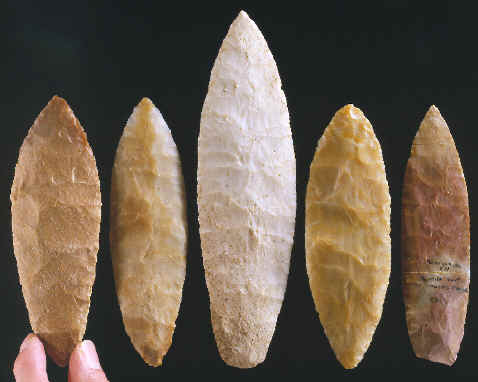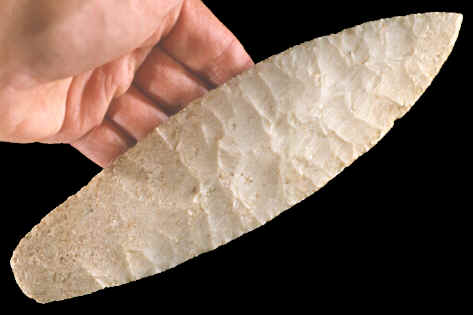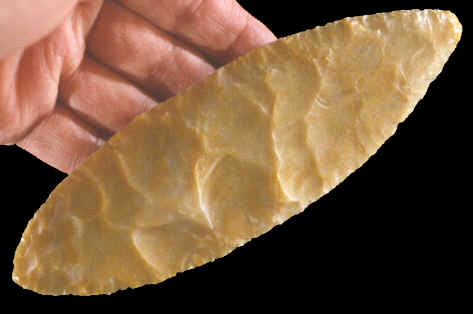|
|
|
During the Gilcrease Survey of the Ramey site at Cahokia in 1957, Ramey knives were found either on house floors or with burials. Perino reports that Ramey knives were also found with burials on the Schild site in Green County, the Emmons site in Fulton County and the Gully Pond site in Clinton County, Illinois. |
|
|
Ramey knives are fairly rare and apparently not many Cahokia people owned them. The common knife used for cutting at that time were simple flakes. Utilized flakes are in fact the most common stone tool type that is found on ancient sites around the world. At the opposite end of the spectrum, Ramey knives are a much more complex knife form. They were apparently used for both utilitarian and ceremonial applications. |
|
|
Ramey knives represent the third largest flaked stone tool that was produced by Cahokia flint knapping craftsmen. Spades and notched hoes come in first and second. The average size of Ramey knives are between 6 and 9 inches (15.2 and 22.9 cm) long. But they have been reported up to 18 1/2 inches (47 cm) long and as small as 3 inches (7.6 cm) long. The longest specimens are generally referred to as swords. |
|
|
Ramey knives were probably made for a variety of reasons. Although their purpose may be less obvious than that of spades and notched hoes. We do know that they wouldn't exist without a good source of large pieces of chert. Most spades, notched-hoes and Ramey knives were made of Mill Creek chert. Only a small percentage were made of Kaolin or Burlington chert. The source for Mill Creek chert is Union & Alexander Counties in southern Illinois. This area produces chert concretions that have weathered out of the limestone formations. These flat irregular shaped nodules were perfect for making Ramey knives and large digging tools that were so necessary in an agricultural society. The Mill Creek quarries were one of the most important sources of raw materials available to the Cahokia economy. |
|
|
|
|
It's interesting that during the next 700 and 800 years after the Cahokia people began making their large bifacially flaked knives, that large knives also appear in other cultures. The Caddo culture began making them in Arkansas, eastern Texas and at Spiro in Oklahoma. Duck River swords began to be made around 1200 A.D. in Tennessee. Aztec bifaces also began to be made about this time, far to the south, in the central valley of Mexico and large Maya culture knives appear at least as far south as Guatemala. Some of them look identical to the ones that were being made at Cahokia. |
|
| CONTINUE ON TO PAGE THREE | |
|
"REFERENCES"
1912,
Hodge, Frederick Webb, "Handbook of American Indians, North
of Mexico," p. 717. |
|




